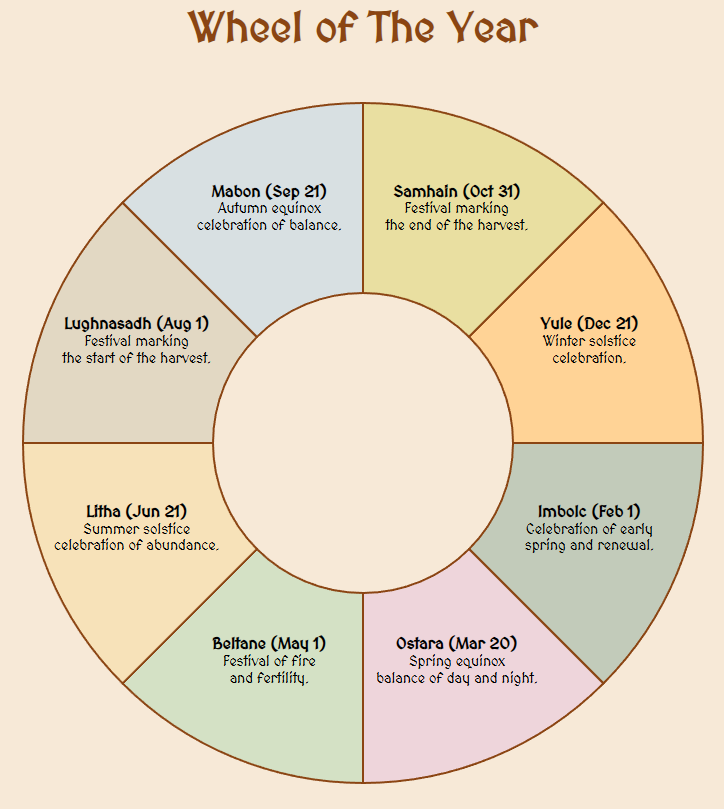Exploring the Pagan Wheel of the Year
The Pagan Wheel of the Year is an annual cycle of seasonal festivals observed by many modern Pagans. It consists of eight festivals, also referred to as Sabbats, that mark the shifts in seasons and celebrate nature's continuous cycle of birth, growth, death, and rebirth. Inspired mostly by the pre-Christian traditions of northern Europe, the Pagan Wheel of the Year has become a crucial aspect of many contemporary Pagan traditions.
 The year begins on Samhain (pronounced Sow-en), observed on October 31. Samhain is sometimes regarded as the 'witches' new year' and is a time to remember the dead and honor ancestors. The veil between our living world and the afterlife is believed to be thinnest during Samhain, making it a potent time for communication with the other side.
The year begins on Samhain (pronounced Sow-en), observed on October 31. Samhain is sometimes regarded as the 'witches' new year' and is a time to remember the dead and honor ancestors. The veil between our living world and the afterlife is believed to be thinnest during Samhain, making it a potent time for communication with the other side.
Following Samhain comes Yule, pagan wheel of the year celebrated during the winter solstice in December. Yule signifies the rebirth of the Sun and the return of light. Traditions include burning the Yule log, decorating a Yule tree, and exchanging gifts.
Next, around February 1 or 2, there is Imbolc, sometimes known as Candlemas. It marks the start of the lambing season and the return of spring. Rituals and customs associated with Imbolc often involve purification and preparation for the coming agricultural season.
Ostara, or the Spring Equinox, is celebrated around March 21. This rite marks the balance of night and day and the burgeoning of new life in nature. Eggs, symbolizing new life, and hares, associated with fertility, feature prominently in Ostara rituals.
Beltane, celebrated on May 1, the wheel of the year marks the beginning of summer. This is a joyous celebration of fertility, abundance, and the vibrant life-force within nature. The Maypole dance is a common tradition during Beltane.
Litha, the summer solstice, is observed around June 21. It celebrates the power of the Sun at its zenith, and rituals often involve bonfires and feasting.
Celebrated on August 1, Lammas, or Lughnasadh, is the first of the three harvest festivals on the Wheel of the Year. It marks the beginning of the wheat harvest and is a time to honor the abundance of the Earth.
The last festival is Mabon, or the Autumn Equinox, celebrated around September 21. It marks the second harvest festival and a time of giving thanks for the bounties of the Earth.
The festivals of the Wheel of the Year represent a cyclical understanding of time, where each end is a new beginning. They teach respect for the Earth and its rhythms, the importance of both light and darkness, and the interplay between life and death. Each festival has its unique customs and rituals, wheel of the year but all share common themes of honoring nature's cycles and connecting with the sacredness of the Earth. In engaging with these traditions, contemporary Pagans seek both a connection with the past and a way to address the spiritual needs of the present. The Pagan Wheel of the Year offers a rich, nature-based spiritual path that many find fulfilling and meaningful.
 The year begins on Samhain (pronounced Sow-en), observed on October 31. Samhain is sometimes regarded as the 'witches' new year' and is a time to remember the dead and honor ancestors. The veil between our living world and the afterlife is believed to be thinnest during Samhain, making it a potent time for communication with the other side.
The year begins on Samhain (pronounced Sow-en), observed on October 31. Samhain is sometimes regarded as the 'witches' new year' and is a time to remember the dead and honor ancestors. The veil between our living world and the afterlife is believed to be thinnest during Samhain, making it a potent time for communication with the other side.